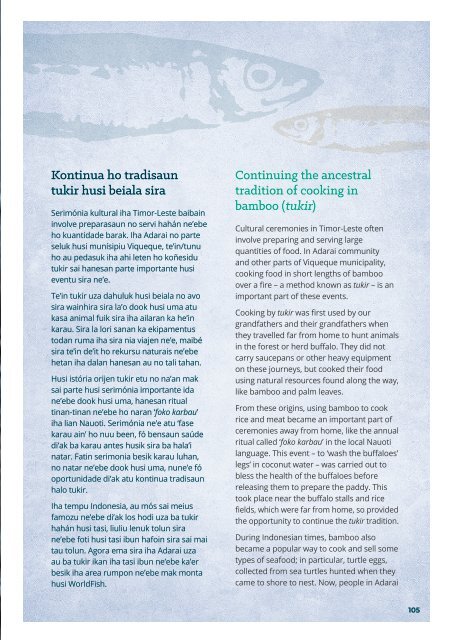You also want an ePaper? Increase the reach of your titles
YUMPU automatically turns print PDFs into web optimized ePapers that Google loves.
Kontinua ho tradisaun<br />
tukir husi beiala sira<br />
Serimónia kultural iha Timor-<strong>Leste</strong> baibain<br />
involve preparasaun no servi hahán ne’ebe<br />
ho kuantidade barak. Iha Adarai no parte<br />
seluk husi munísipiu Viqueque, te’in/tunu<br />
ho au pedasuk iha ahi leten ho koñesidu<br />
tukir sai hanesan parte importante husi<br />
eventu sira ne’e.<br />
Te’in tukir uza dahuluk husi beiala no avo<br />
sira wainhira sira la’o dook husi uma atu<br />
kasa animal fuik sira iha ailaran ka he’in<br />
karau. Sira la lori sanan ka ekipamentus<br />
todan ruma iha sira nia viajen ne’e, maibé<br />
sira te’in de’it ho rekursu naturais ne’ebe<br />
hetan iha dalan hanesan au no tali tahan.<br />
Husi istória orijen tukir etu no na’an mak<br />
sai parte husi serimónia importante ida<br />
ne’ebe dook husi uma, hanesan ritual<br />
tinan-tinan ne’ebe ho naran ‘foko karbau’<br />
iha lian Nauoti. Serimónia ne’e atu ‘fase<br />
karau ain’ ho nuu been, fó bensaun saúde<br />
di’ak ba karau antes husik sira ba hala’i<br />
natar. Fatin serimonia besik karau luhan,<br />
no natar ne’ebe dook husi uma, nune’e fó<br />
oportunidade di’ak atu kontinua tradisaun<br />
halo tukir.<br />
Iha tempu Indonesia, au mós sai meius<br />
famozu ne’ebe di’ak los hodi uza ba tukir<br />
hahán husi tasi, liuliu lenuk tolun sira<br />
ne’ebe foti husi tasi ibun hafoin sira sai mai<br />
tau tolun. Agora ema sira iha Adarai uza<br />
au ba tukir ikan iha tasi ibun ne’ebe ka’er<br />
besik iha area rumpon ne’ebe mak monta<br />
husi WorldFish.<br />
Continuing the ancestral<br />
tradition of cooking in<br />
bamboo (tukir)<br />
Cultural ceremonies in Timor-<strong>Leste</strong> often<br />
involve preparing and serving large<br />
quantities of food. In Adarai community<br />
and other parts of Viqueque municipality,<br />
cooking food in short lengths of bamboo<br />
over a fire – a method known as tukir – is an<br />
important part of these events.<br />
Cooking by tukir was first used by our<br />
grandfathers and their grandfathers when<br />
they travelled far from home to hunt animals<br />
in the forest or herd buffalo. They did not<br />
carry saucepans or other heavy equipment<br />
on these journeys, but cooked their food<br />
using natural resources found along the way,<br />
like bamboo and palm leaves.<br />
From these origins, using bamboo to cook<br />
rice and meat became an important part of<br />
ceremonies away from home, like the annual<br />
ritual called ‘foko karbau’ in the local Nauoti<br />
language. This event – to ‘wash the buffaloes’<br />
legs’ in coconut water – was carried out to<br />
bless the health of the buffaloes before<br />
releasing them to prepare the paddy. This<br />
took place near the buffalo stalls and rice<br />
fields, which were far from home, so provided<br />
the opportunity to continue the tukir tradition.<br />
During Indonesian times, bamboo also<br />
became a popular way to cook and sell some<br />
types of seafood; in particular, turtle eggs,<br />
collected from sea turtles hunted when they<br />
came to shore to nest. Now, people in Adarai<br />
105

















